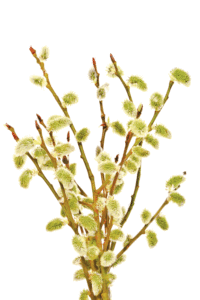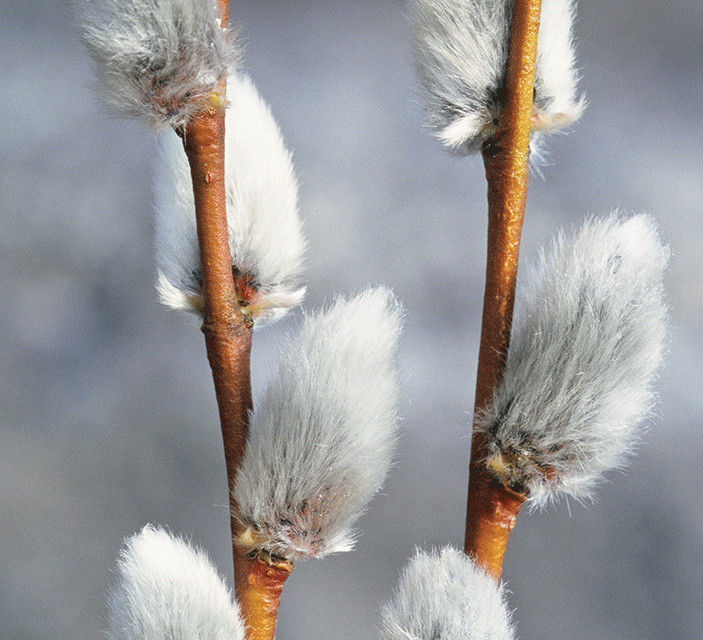A robin’s song used to be the first sign of spring. 
But with robin migrations mitigated by warming temperatures, now the lucky robin plucking a worm from the warming soil is also regarded as the true harbinger.
But for evidence pointing to winter winding down, there’s an even earlier “bird” to watch for, a different “animal” altogether — the pussy willow, which makes its debut in late February and March here in the Mid-Atlantic region.
Known scientifically by its proper Latin name, Salix Discolor, it’s native not only to Maryland but throughout large swaths of the northern United States and Canada, delightfully denoted by the silvery gray furry “toes” found on the male tree. (Pussy willows are dioecious, growing separately as male and female tree, with the less showy female variety featuring greenish catkins.)
Non-native varieties from Europe and Asia, displayed in botanical gardens and available through niche garden supply providers, offer an array of surprising colors and shapes, including Japanese varieties Salix gracilystila (rose gold), Salix gracilystila melanostachys (black, actually deep reddish purple) Salix udensis or Sekka (fan tailed), Salix acutifolia (long leafed), the European/West and Central Asian Salix capria or goat willow (greyish with yellow “antlers”) and Chinese native Salix Matsudana ‘Tortuosa’ (aka Dragon’s Claw Willow).
With feline-plush branch tips called catkins (from the late 16th century Dutch word katteken meaning kitten), the wetland loving shrub’s young buds emerge well protected against winter’s last gasps of chilly air, bringing a supple joy to souls starved for any signal of spring’s eagerly awaited arrival, whether from the florist shop or a “first nice day” foray into countryside surroundings.
Despite bringing often unbridled delight to kids and adults alike, perhaps the biggest buzz around pussy willows is elicited from insects, who also get antsy to explore when milder temperatures allow.
The enticingly soft fuzzy tussocks, which are actually unopened buds, appear generously dusted with pollen, readily providing nature’s first course to critters before fruit trees and others even begin to bloom.
Honey, mining, and mason bees particularly partake of the vital nourishment.
For moths and butterflies, meanwhile, pussy willows serve as a crucial larval staging ground.
Chesapeake Bay area garden writer Patricia Acton, who prefers to enjoy pussy willows from the comfort of her own home garden, recommends inserting within a 4-inch pot of dampened soil then set aside in a cool, dark spot.
When roots begin protruding from the drainage hole, set out to its intended growing location on porch or deck, and/or repot in a roomier container.
Veteran gardening writer David Beaulieu noted that planting pussy willows directly into the ground in summer is easy, but recommends using a cutting taken from new (not gray) growth, of pencil sized thickness a foot long, placing the cut part directly into the ground of a depth of a few inches, leaving several knobby nodes visible.
You can curate a cutting earlier, then root it in water inside until the ground poses no threat from freezing.
The generally low maintenance pussy willow requires regular pruning to prevent growth from running amok, but regenerates fairly quickly following even thorough trimming.
While preferring full sun, it can get by with less.
Thriving in dank soil, it works for a rain garden or any spot with less than ideal drainage, but tolerates dry soil if watered sufficiently.
The generally endearing qualities of the prolific pussy willow carry one caveat for the gardener: its wide ranging roots can run amok, so avoid planting too close to septic systems or leaking underground pipes.
Pussy willows whisper ‘Welcome, spring’




